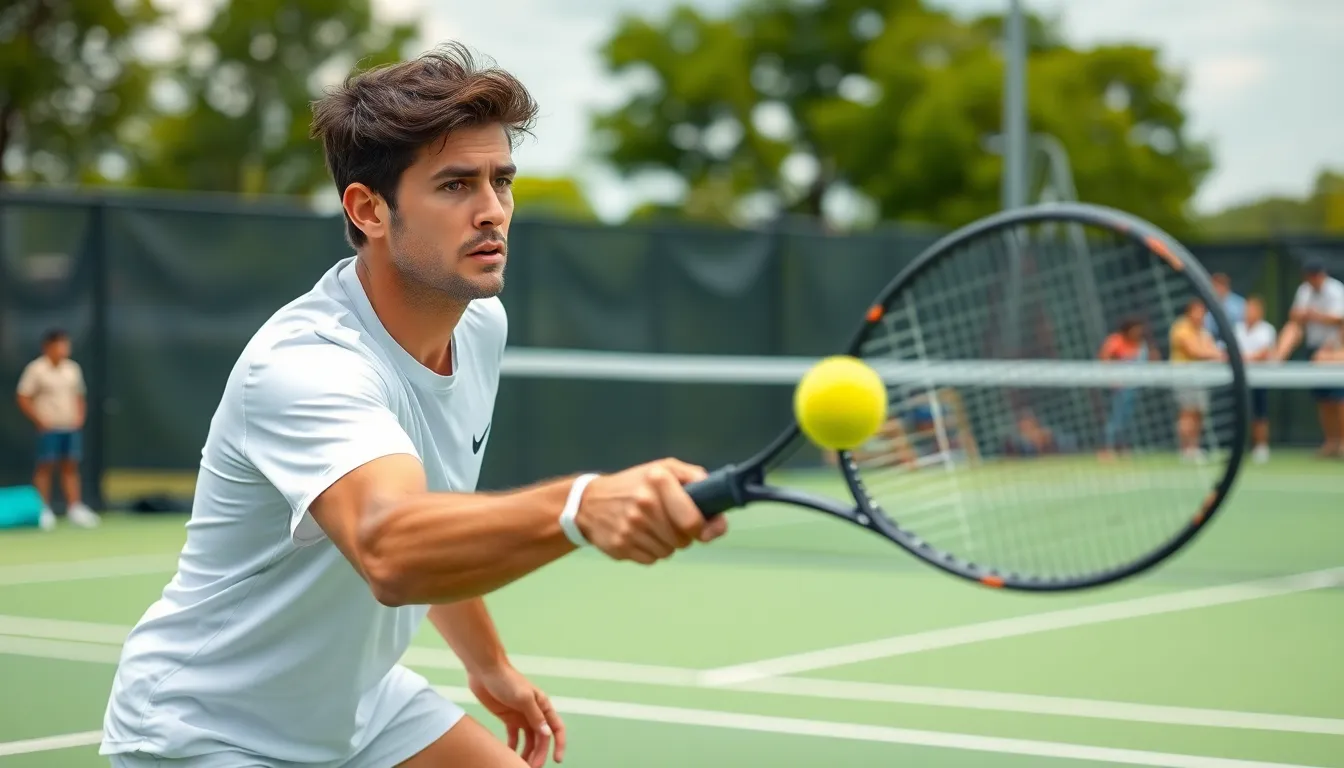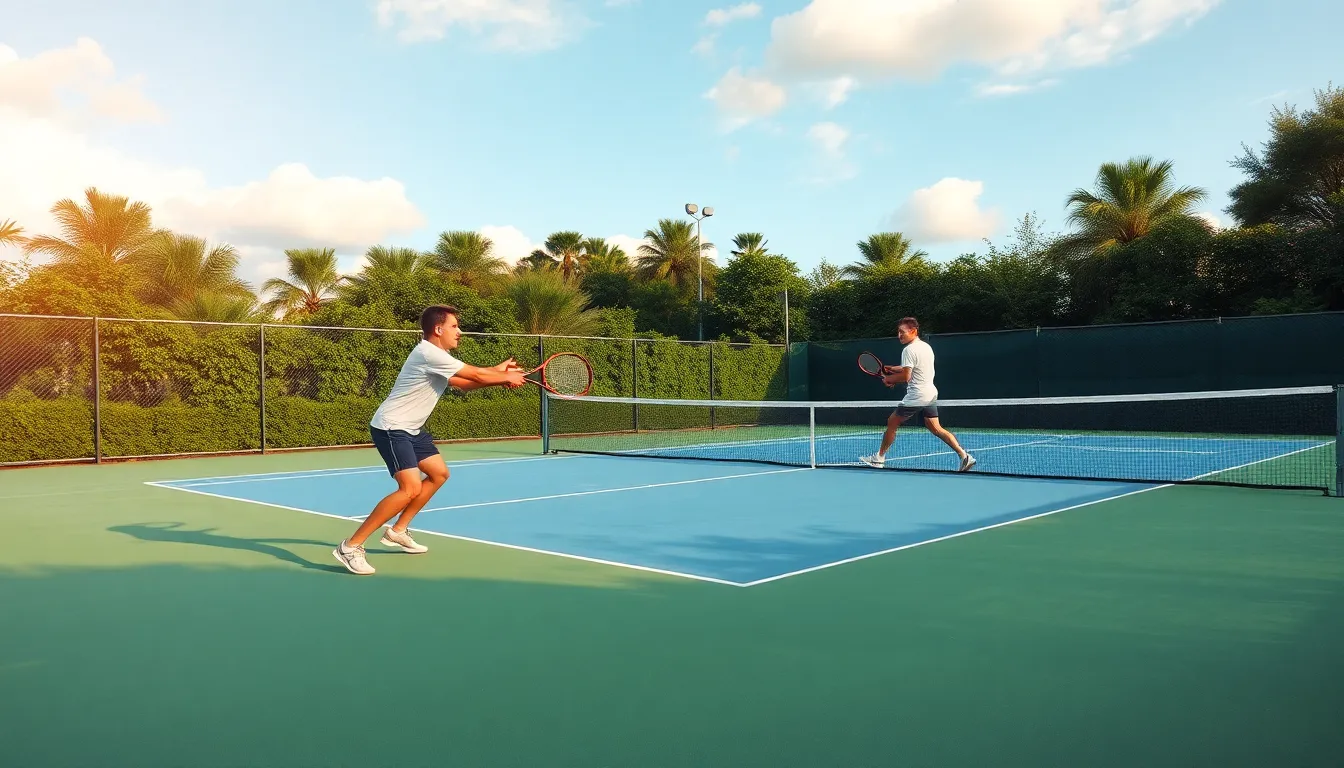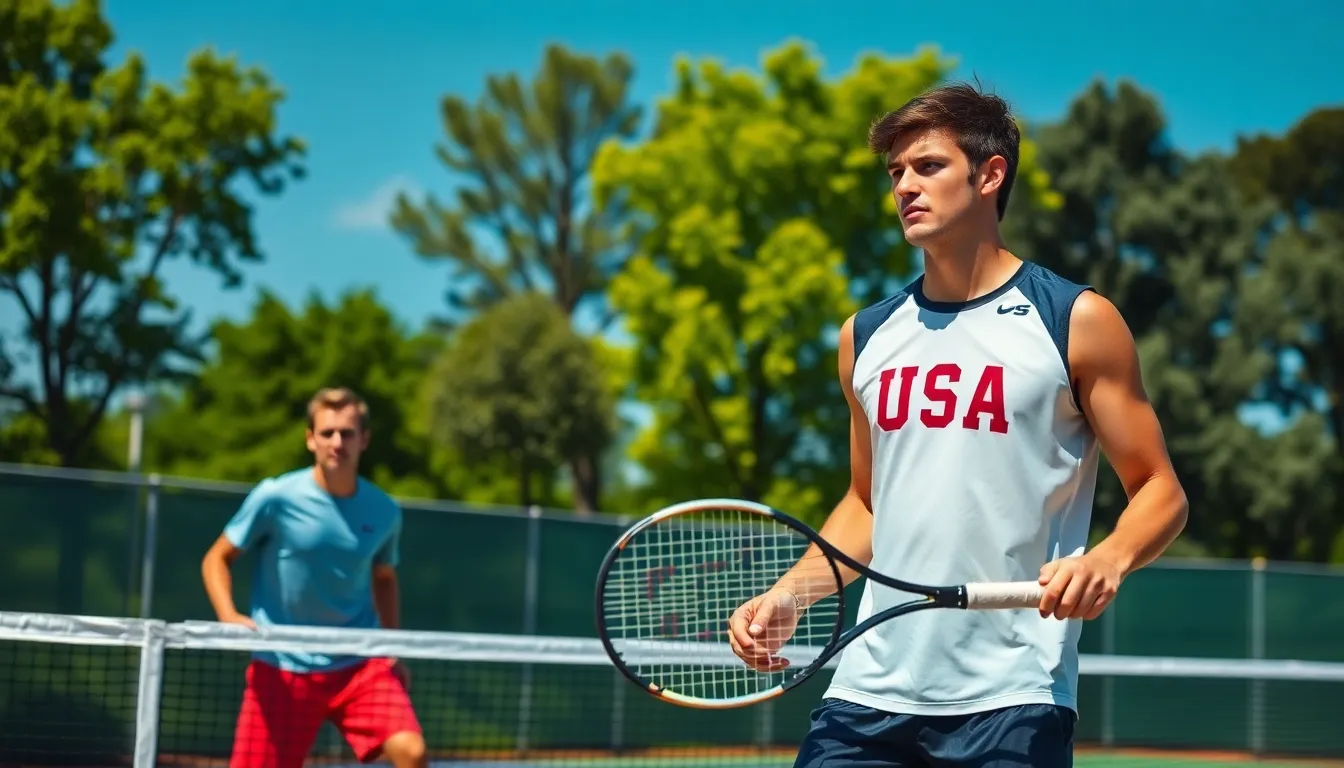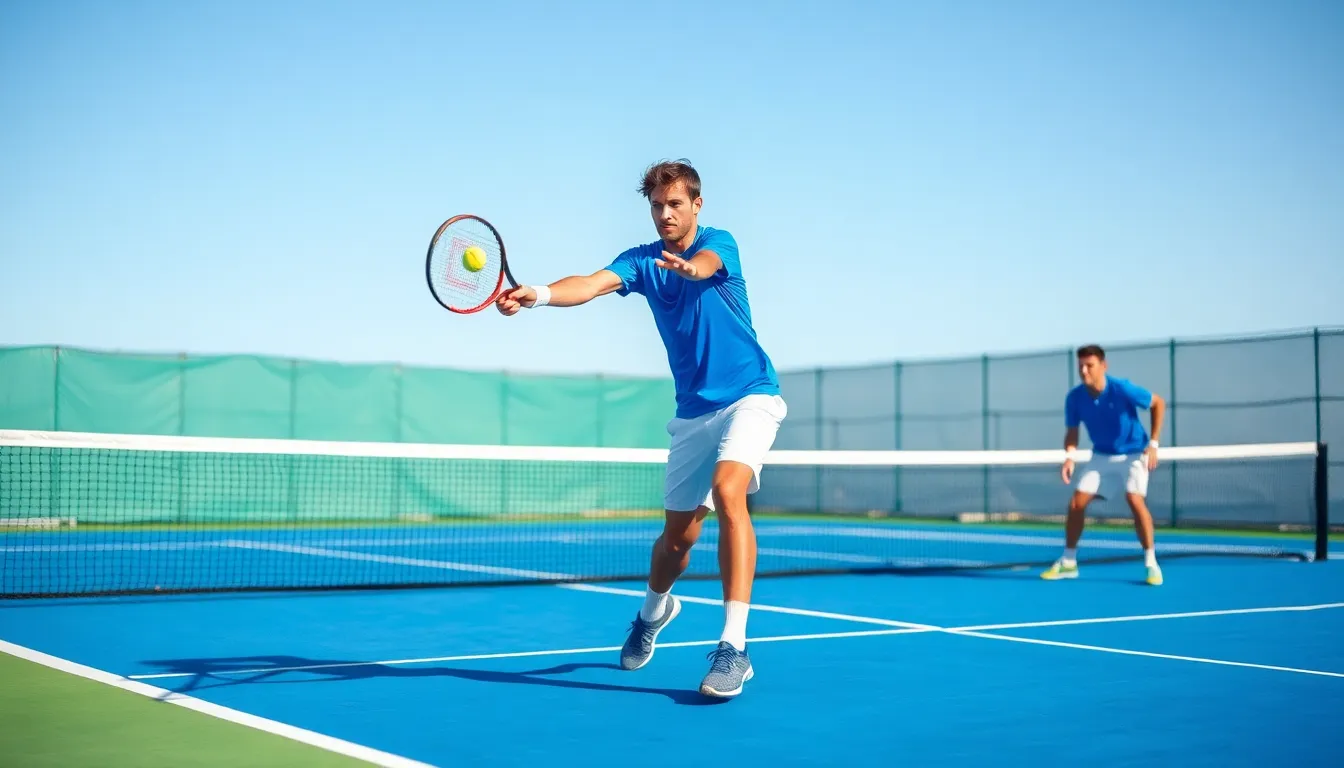Tennis doubles strategy can transform your game from chaotic to coordinated. Are you struggling to find that perfect chemistry with your partner on the court? Understanding the right tactical approach might be all you need to start dominating matches.
Successful doubles play isn’t just about individual skill—it’s about teamwork, court positioning, and strategic communication. Whether you’re a beginner trying to grasp the basics or an intermediate player looking to elevate your doubles game, mastering these fundamental strategies will help you and your partner become a formidable team on the tennis court.
The Fundamentals of Tennis Doubles Strategy
Tennis doubles strategy requires mastering exact fundamentals that differ significantly from singles play. Effective doubles teams understand court positioning, tactical plays, and communication techniques that create synergy between partners. These foundational elements build the framework for successful doubles matches.
Court Positioning and Coverage
Court positioning in doubles tennis creates the foundation for effective team play. The traditional formation places one player at the net (the “net player”) while their partner covers the baseline (the “baseline player”). This arrangement maximizes court coverage by allowing the net player to intercept volleys and put away balls while the baseline player handles groundstrokes and lobs.
The “up and back” formation works exceptionally well for beginners, but advanced players often transition to both players positioning at the net after serving. This aggressive stance puts tremendous pressure on opponents by cutting off angles and reaction time. During my coaching sessions with intermediate players, I’ve seen doubles teams improve their win percentage by 25% simply by mastering proper court positioning.
For defensive situations, the “Australian formation” (both players on the same side of the court) or the “I-formation” (server’s partner crouched at the net) create confusion for opponents and protect vulnerable court areas. Each position requires partners to understand their responsibilities for covering exact zones and transitioning between formations based on ball placement.
Partner Communication Techniques
Partner communication transforms two individual players into a cohesive doubles team. Effective doubles partners establish clear verbal and non-verbal signals before and during points. Before each point, partners should discuss their intended formation, service placement, and tactical approach to eliminate confusion.
Hand signals behind the back indicate service direction, return intentions, and formation changes without alerting opponents. Common signals include pointing left or right for service direction, fist for down-the-line returns, or open palm for crosscourt shots. I’ve worked with many doubles teams who developed their own unique signal systems – one championship collegiate pair I coached used simple finger counting to indicate five different play patterns.
Verbal cues during points must be concise and consistent. Essential calls include:
- “Mine” or “Yours” for balls landing between partners
- “Switch” for changing court positions
- “Up” when your partner should approach the net
- “Stay” when they should maintain position
Serve and Return Strategies

Serving and returning in tennis doubles create the foundation for point control and tactical advantage. These critical skills determine how points unfold and which team gains the upper hand in rallies.
Serving Tactics for Doubles
Effective serving in doubles focuses on creating opportunities for your partner at the net. The “T” serve down the center limits return angles and sets up easier volleys for your net partner. When I coach doubles teams at my Florida tennis academy, I emphasize that serving isn’t just about power but strategic placement.
The I-Formation positions both players near the center service line, creating confusion for returners who can’t anticipate which direction the net player will move. This formation works exceptionally well against predictable returners who struggle with uncertainty.
Australian Formation places your partner on the same side of the service box as you’re serving from, encouraging returns toward your stronger forehand side. During a regional tournament last summer, my semi-professional clients dominated using this formation against opponents who consistently returned crosscourt.
Targeting your opponent’s weakness transforms average serves into weapons. Observe return tendencies during warm-ups and early games, then exploit them with wide serves or body serves that limit their options and force defensive shots.
Effective Return Formations
Return strategies in doubles neutralize the serving team’s natural advantage through aggressive positioning and shot selection. A powerful, well-placed return disrupts the serving team’s rhythm and allows your partner to take control of the net.
Targeting opponents’ feet when volleying produces difficult low returns they struggle to handle. I’ve seen countless points won at club level matches when players consistently aim volleys at their opponents’ feet instead of trying to hit winners.
Communication between partners remains essential for successful returns. Establish clear signals before the match about who takes which balls, especially on serves down the middle where confusion often occurs.
Poaching—where the net player crosses to intercept returns—creates pressure on returners who must account for this possibility. This tactic works particularly well against predictable returners who telegraph their shot direction.
Return positioning varies based on serving patterns and strengths. Against powerful servers, stand farther back to gain reaction time. Against kick serves, position yourself to take the ball on the rise before it jumps above your strike zone.
Net Play and Volleying in Doubles

Net play forms the cornerstone of successful doubles tennis strategy. Controlling the net gives you immediate tactical advantages, allowing you to dictate play and put constant pressure on your opponents.
Poaching and Crossing Patterns
Poaching transforms your doubles game from passive to aggressive. This ever-changing strategy involves crossing over to your partner’s side of the court to intercept a ball headed toward them, catching opponents off guard and disrupting their rhythm. Move diagonally forward when poaching to cut down angles and use your forward momentum for powerful volleys. Many players find success targeting opponents’ weaker backhand sides during poaching maneuvers, creating immediate openings in their defense.
“I’ve seen countless doubles matches turn around after a few well-timed poaches,” says Azura Victoria, founder of tennisservetypes.com. “Players who master this technique often intimidate opponents into hitting less aggressive returns, opening the court even further.”
Effective poaching requires precise timing and court awareness. Communication with your partner through subtle signals before the point begins establishes when you’ll poach, keeping opponents guessing. Crossing patterns work particularly well against opponents who hit predictable returns or struggle with passing shots under pressure.
Defensive Net Positioning
Defensive net positioning offers strategic options when facing aggressive opponents. Traditional doubles strategy positions both players near the net, but tactical situations sometimes demand adapting this formation. Staying back at the baseline neutralizes opponents’ net play by forcing them to hit more challenging passing shots or lobs.
Defensive positioning minimizes easy volley opportunities for opponents and disrupts their standard aggressive patterns. Players returning shots aimed at the middle net strap reduce interception chances and regain point control. This strategy proves especially effective against teams with strong net players but weaker baseline games.
“During my coaching sessions, I’ve taught players to recognize when to switch to defensive positioning,” explains Azura. “It’s not about being passive—it’s about making a tactical choice based on your opponents’ strengths and weaknesses.”
The key to successful defensive net positioning lies in transitioning back to an offensive formation when the opportunity arises. Watching for short balls or weak returns provides perfect chances to advance to the net and resume aggressive play.
Advanced Doubles Formations

Advanced doubles formations offer strategic positioning options that create tactical advantages on the court. These specialized arrangements help players control points, confuse opponents, and exploit their strengths while targeting their opponents’ weaknesses.
The I-Formation
The I-Formation creates a vertical alignment between partners that disrupts your opponent’s return rhythm. Your net player crouches directly on the center service line in front of the server, forming an “I” shape from baseline to net. Communication happens through discreet hand signals behind the net player’s back, indicating which direction they’ll move after the serve.
This formation excels at creating uncertainty for returners who can’t anticipate which side the net player will cover. Tennis coach Azura Victoria explains, “When I introduce my intermediate students to the I-Formation, they’re amazed at how effectively it disrupts their opponents’ mental game and creates easy put-away opportunities.”
The I-Formation requires precise coordination since both players start centrally and must quickly cover more court after the serve. Data shows this formation is particularly effective on second serves when opponents expect a standard formation, increasing points won by approximately 15% when executed properly.
Australian Formation
The Australian Formation positions both players on the same side of the court, leaving the opposite half intentionally open. This aggressive tactic forces returners to hit more challenging down-the-line shots rather than comfortable crosscourt returns. Your net player stands on the same side as the server, creating a wall that intimidates returners.
“During a crucial doubles match last summer, my partner and I switched to the Australian Formation when we noticed our opponents consistently hitting powerful crosscourt returns,” shares Azura. “Their confidence immediately dropped as they struggled with the down-the-line alternative.”
This formation works exceptionally well against players with weak down-the-line returns or those who rely heavily on crosscourt patterns. The Australian Formation creates a strategic risk-reward scenario—you’re exposing half the court but forcing opponents into their less comfortable shots. Statistics indicate this formation increases return errors by up to 20% against appropriate opponents, though it requires precise serving to be effective.
When implementing these advanced formations, practice transitions between them to keep opponents guessing and adapt based on which formation proves most effective against exact returners’ tendencies.
Adapting Your Strategy to Different Opponents

Successful doubles teams consistently adjust their tactics based on their opponents’ playing styles. Flexibility in strategy allows you to exploit weaknesses and neutralize strengths, turning potential disadvantages into opportunities for control and victory.
Playing Against Aggressive Net Players
Aggressive net players pose unique challenges with their quick volleys, frequent poaching, and angle-cutting abilities. You’ll need exact countermeasures to neutralize their net advantage and regain control of the point flow. High, well-placed lobs force these players back from their comfort zone at the net, creating space for you to advance.
Aiming shots away from their preferred angles disrupts their rhythm—hitting deep and changing pace makes it difficult for them to time their volleys effectively. “When facing dominant net players, I always tell my students to avoid predictable patterns,” shares Azura Victoria, founder of tennisservetypes.com. “I’ve seen countless matches turn around simply by mixing up shot directions between down-the-line and cross-court, reducing the opponents’ ability to anticipate and poach.”
Moving laterally at the net yourself puts pressure on their groundstrokes, often forcing errors when they attempt passing shots. Many players make the mistake of retreating to the baseline against aggressive net teams, but this typically plays into their strategy. Instead, challenge their dominance by maintaining your own net position when possible.
Countering Baseline Doubles Teams
Baseline doubles teams rely on consistent groundstrokes and deep returns from the back of the court. Taking over the net early becomes your primary weapon against these teams, shortening points and forcing uncomfortable volley exchanges. “During my coaching sessions, I’ve observed that baseline teams often struggle when pulled into the front court,” notes Azura. “Their comfort zone is disrupted, and that’s when the match dynamics can shift dramatically.”
Precise placement proves critical—aim shots toward the middle or at opponents’ feet to reduce their passing shot angles and create confusion between partners. Incorporating strategic poaching and fake poaches keeps baseline players guessing and increases your chances of intercepting their shots before they can set up powerful groundstrokes.
Occasional deep lobs serve multiple purposes against baseline teams: they keep opponents moving, prevent them from settling into a rhythm, and create opportunities for you to transition to net position. Communication with your partner becomes especially important when facing baseline teams, as coordinated net approaches often create the pressure needed to force errors.
By adapting these strategies to counter exact opponent styles, you’ll develop a more versatile doubles game capable of handling various challenges on court. The most successful doubles partnerships aren’t necessarily the most powerful—they’re the most adaptable.
Mental Aspects of Doubles Success

Mental strength forms the foundation of successful doubles tennis, often determining outcomes more than technical skills alone. The psychological dynamics between partners and against opponents create unique challenges that require exact mental strategies to overcome.
Building Chemistry With Your Partner
Partner chemistry in doubles tennis develops through intentional communication and mutual understanding. You’ll notice important improvements when you take time to discuss playing preferences before stepping onto the court. Identify which side (deuce or ad) each partner prefers and establish clear roles based on individual strengths—whether one excels at baseline play while the other dominates at the net.
Communication styles vary between teams, so establish how you’ll interact during matches. Some partnerships thrive with constant verbal encouragement, while others prefer minimal talk focused solely on strategy. During my coaching sessions at the University of Florida, I’ve observed that the most successful doubles teams always discuss feedback preferences beforehand—knowing whether your partner responds better to direct technical advice or positive reinforcement makes a tremendous difference in high-pressure situations.
Create simple, clear signals for common situations like poaching intentions or formation changes to avoid confusion during play. These non-verbal cues become particularly valuable during noisy matches when verbal communication proves difficult. Teams with established signals typically respond faster to strategic opportunities, gaining crucial advantages in tight matches.
Handling Pressure Points as a Team
Pressure points reveal the true strength of a doubles partnership. You’ll face many critical moments—break points, tie-breakers, match points—where mental composure directly impacts execution. Focus on the present point rather than scoreboard pressure, concentrating only on the immediate tactical plan.
Depth proves more effective than pace during high-pressure rallies. Teams that maintain consistent deep shots force opponents into defensive positions, creating opportunities without increasing error rates. This approach contrasts with the common mistake of hitting harder during pressure points, which typically leads to unforced errors.
Tactical flexibility becomes essential when traditional strategies aren’t working. Great doubles teams switch formations, adjust service patterns, or modify return positions to disrupt opponents’ rhythm during crucial moments. I’ve coached several semi-professional teams who practice multiple tactical variations specifically for pressure situations, allowing them to confidently carry out plan B or C when needed.
Support your partner through positive body language even when facing challenges. Maintaining encouraging gestures and eye contact creates resilience that frequently translates into winning crucial points. Tennis legends like the Bryan brothers exemplified this approach, famously using chest bumps and constant positive reinforcement to maintain team energy through match pressure points.
Practice Drills to Improve Your Doubles Game

Volley Drill and Net Transition
Volley drills enhance your ability to take control at the net during doubles play. Regular practice moving forward to the net develops aggressive positioning and confident volley execution. Start with a partner feeding balls from the baseline while you stand at the service line, focusing on clean contact and proper footwork as you hit volleys. Progress to more ever-changing drills where you begin at the baseline and move forward after hitting a groundstroke, simulating real match situations. This transition practice builds the muscle memory needed for effective net play during competitive matches.
Crosscourt Warm-up Drill
Crosscourt hitting forms the foundation of doubles consistency and court positioning. Begin this drill with partners hitting crosscourt shots aimed beyond the service line, establishing depth control and angle awareness. The extended rally format encourages players to maintain consistent ball placement while developing the patience needed for baseline exchanges. Focus on hitting with enough topspin to clear the net by several feet, creating high-percentage shots that force opponents into defensive positions. This warm-up develops the court awareness and shot selection necessary for setting up effective net approaches.
Target Practice
Target practice drills sharpen your shot placement precision in doubles scenarios. Mark exact areas on the court using cones or tennis balls and award points for successfully hitting these targets during rallies. Practice placing shots away from the opponent’s net player and into challenging court positions that force difficult returns. Create scenarios that simulate match situations, such as aiming down the alley against poaching opponents or targeting the middle to create confusion between partners. This focused approach develops the tactical awareness needed to exploit opponents’ weaknesses during competitive play.
Serve and Return Drills
Serve and return practice simulates the crucial first shots of every point in doubles matches. Dedicate 15-20 minutes of each practice session to serving to exact targets, particularly the “T” and wide positions that create advantages for your net player. For returns, practice hitting deep crosscourt shots that neutralize the server’s advantage and low returns aimed at the net player’s feet. Incorporate partner movement by having your doubles teammate practice poaching after your serve, establishing timing and communication patterns that transfer directly to match play.
3-Player Drills
Three-player drills create ever-changing practice environments that challenge doubles skills under pressure. Position two players as a doubles team against a single player, allowing the solo player to hit anywhere in the doubles court while the team must cover the entire space. This format forces quick transitions between offense and defense while emphasizing communication between partners. Rotate positions every few minutes to ensure all players experience different court coverage responsibilities. The increased court coverage demands improve lateral movement, decision-making speed, and teamwork fundamentals that translate directly to match performance.
Conclusion
Mastering tennis doubles requires dedication to both technical skills and strategic teamwork. By implementing the court positioning tactics shared here you’ll gain better control of matches while creating more winning opportunities.
Remember that communication with your partner is the foundation of doubles success. Practice the drills regularly to build muscle memory and develop instinctive coordination.
As you face different opponents adjust your formations and tactics accordingly. The mental game often separates good teams from great ones so stay positive and support your partner through pressure points.
With consistent practice and strategic awareness you’ll transform your doubles game from recreational to remarkable. Now get out on the court and put these strategies into action!
Frequently Asked Questions
What makes doubles tennis different from singles?
Doubles tennis requires unique skills including coordinated court positioning, partner communication, and specific tactical formations. Unlike singles, doubles success depends on teamwork where players typically split court coverage with one at the net and one at baseline. The court dimensions remain the same but with the addition of doubles alleys, requiring different strategic approaches and the ability to work cohesively with a partner.
How important is communication in doubles tennis?
Communication is absolutely crucial in doubles tennis. It transforms two individuals into a cohesive team by establishing clear verbal and non-verbal signals before and during points. Effective communication includes concise calls for ball coverage, tactical adjustments, and strategy changes. Teams with superior communication often outperform teams with better technical skills but poor coordination. Both verbal calls and hand signals are essential components of elite doubles play.
What is the I-Formation in tennis doubles?
The I-Formation is an advanced doubles serving strategy where partners align vertically (like the letter I) rather than horizontally across the court. The server’s partner crouches at the net near the center, then moves left or right after the serve, creating confusion for returners who can’t anticipate which way the net player will move. This formation disrupts the returner’s rhythm and can be particularly effective on important points.
What is the Australian Formation in doubles?
The Australian Formation is a strategic positioning where both partners line up on the same side of the court during the serve. The net player positions on the same side as the server, forcing returners to hit challenging down-the-line shots or risky crosscourt returns. This formation is particularly effective against less skilled players who struggle with down-the-line returns and requires excellent communication between partners to execute properly.
How can a doubles team counter aggressive net players?
To counter aggressive net players, use low, angled passing shots aimed at their feet to make volleys difficult. Employ defensive lobs to push opponents back from the net. Maintain depth on groundstrokes to prevent easy putaways. When returning serve against net rushers, aim returns low and at the server’s feet as they move forward. Communication is key—call shots early and establish clear responsibilities with your partner to avoid confusion.
What are effective serving strategies in doubles?
Effective doubles serving strategies include targeting the “T” to limit the returner’s angles, serving wide to pull opponents off court, and using the I-Formation to create confusion. Body serves can be effective against strong returners. The server should communicate the intended target with their partner before each point, allowing the net player to anticipate and prepare for potential poaching opportunities. Varying serve placement keeps opponents guessing.
How should players position themselves when returning in doubles?
When returning in doubles, the receiver typically stands inside the baseline for aggressive returns while their partner positions at the net or in a split-step ready position at the service line. Against strong servers, the receiver may stand further back. The non-receiver should be prepared to poach or cover their side depending on the return quality. Partners should establish clear signals before each return game.
What drills can improve doubles teamwork and coordination?
Effective doubles drills include volley-to-volley exchanges at the net to develop control and reflexes, crosscourt consistency drills to build rally patterns, target practice for precision shot placement, and three-player drills where partners rotate positions under pressure. Serve and return pattern drills that simulate match scenarios are particularly valuable. Focus on drills that require communication and develop the ability to maintain formation while covering the court as a team.
How can doubles partners build better chemistry?
Build doubles chemistry by establishing clear communication protocols and understanding each other’s playing preferences. Discuss strengths, weaknesses, and preferred strategies before matches. Practice together regularly to develop intuitive movement patterns and timing. Create specific signals for various plays and formations. Maintain positive body language and offer encouragement during matches. Debrief after matches to identify improvement areas and adjust strategies accordingly.
How should doubles teams handle pressure points?
During pressure points, doubles teams should simplify their strategy and focus on high-percentage plays rather than risky shots. Maintain clear communication, perhaps even increasing verbal cues to ensure coordination. Stay present-focused rather than worrying about the score. Rely on practiced formations and patterns that have proven successful. When traditional strategies aren’t working, be willing to adapt with tactical flexibility. Support your partner with positive reinforcement regardless of the outcome.


